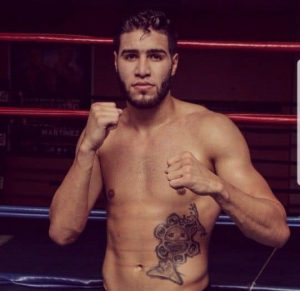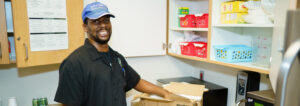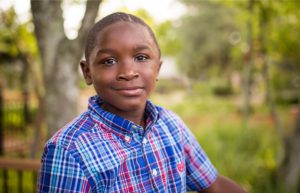Fighting a New Opponent: Brain Injury

Back to physical health resource hub
Haga clic aquí para leer en español
On Oct. 17, 2015, American-Puerto Rican professional boxer Prichard Colón’s life was forever changed. Prichard’s professional record was 16-0 when he entered the ring for a 10-round welterweight fight. During the match, he was struck in the back of the head multiple times. He fell to his knees and said he felt dizzy as his mother, Nieves Colón, helped him back to his dressing room. He started vomiting, collapsed and was rushed to the hospital.

Prichard suffered a massive brain bleed from the repeated hits. This led to swelling around his brain that required a left hemisphere craniotomy, a removal of part of his skull, to allow the brain to expand and heal. Prichard was in a coma for over a year. Though he received acute hospital and inpatient rehabilitation out of state, he had not improved beyond an unresponsive wakefulness state (UWS) – previously called the vegetative state. Individuals in UWS have a sleep/wake cycle but do not otherwise interact in a meaningful way.
Nieves, now his full-time caregiver, continued to search for answers and someone who could help her son. After a visit with a neurologist in September 2017, Nieves was told the crushing news that she shouldn’t expect any additional improvement from Prichard.
It was then that Nieves searched and found Dr. Kenneth Ngo with Brooks Rehabilitation. In December 2017, she brought Prichard from their home in Winter Park, Fla., to Jacksonville, Fla., for an evaluation with Dr. Ngo that offered their first glimmer of hope. He determined Prichard would be a good candidate for Brooks’ comprehensive outpatient therapy programs.
Prichard began outpatient therapy at Brooks’ largest clinic. His therapist noticed he was tracking with his eyes and contacted Alisha Russell, M.S., CCC-SLP, for an eye-gaze evaluation. Russell was the lead therapist for the Brooks Rehabilitation Alternative Voices or BRAV. BRAV is an augmentative and alternative Communication (AAC) specialty at Brooks.
In March 2018, Russell met Prichard and started along the most significant road in his recovery. Prichard’s brain damage impaired his ability to move his body and speak. Prichard’s family and doctors were unable to tell if he was emerging or even if he understood what was going on around him. “He was essentially locked inside his body and no one was listening to his eyes. Once we showed him we were listening, I believe it helped him emerge more,” said Russell.
After calibrating his eyes to an AAC device, Prichard was able to answer yes/no questions in both English and Spanish at 80 percent accuracy by looking at his answer choices on the screen. There was finally proof that Prichard was aware and capable of communicating. Nieves cried tears of joy.
While Prichard used to train for boxing matches, he now began the tough training to regain the skills he lost. Both his cognitive and physical endurance was very low. Initially, he was only able to tolerate about 45 minutes of an hour long session. Russell started teaching him cause and effect with his eyes. Session after session, they repeated motor learning approaches to navigate the speech-generating device (SGD) until he could navigate independently to communicate his basic wants and needs. Prichard is a music lover, and his humor could not be contained. He was excited when he was finally able to ask for his favorite songs, tell a joke and tell his family, “I love you.”
Nieves was driving Prichard two and a half hours up to Orange Park, Fla., from their home in Winter Park, Fla., four days a week for speech therapy. Little by little, he was able to move a toe or a finger. When this movement started to increase, the team recommended that Prichard begin physical and occupational therapy, too. Nieves made the decision to stay at Helen’s House, Brooks’ family housing during the week so Prichard could attend several hours of therapy per day.
When Prichard began occupational therapy in June 2018, he had no active movement in either arm. April Coats, OTR, Brooks Rehabilitation Orange Park center manager, worked on range of motion using electrical stimulation to jumpstart his muscles. She utilized a deltoid sling for early motion, along with splinting. Prichard first started getting elbow movement back followed by wrist and finger movement. By the beginning of 2019, he could do some shoulder work, grasp and release pegs and follow commands. As his right hand continued to improve, they worked on more functional activities like simulated feeding and gestures.
In physical therapy, Prichard was unable to move any of his limbs on command and required a Hoyer lift to help him transfer from his wheelchair to a treatment table. It did not take Prichard long to progress as he was able to stand with some assistance after just one month of hard work. Brian Ericksen, PT, DPT, focused on improving his balance in the seated position, improving the strength in his legs so he could help with transfers and attempted to manage his spasticity with activities like assisted walking and standing. With Prichard’s work ethic and his mother’s constant encouragement, he was able to keep improving his condition day after day.

Prichard has since walked about the length of a football field with the help of therapists and some assistive devices. He can maintain his balance while sitting unsupported for over five minutes, and can stand, with some assistance, to help make his transfers easier on those helping him. “The only barrier to Prichard’s success has been his unrelenting desire to flirt with every female in the clinic. Prichard may be competing for something different now than he was earlier in his life, but he has never stopped being a champion,” said Ericksen. Prichard’s remarkable progress captured the attention of national and international media outlets. The Washington Post, Univision and WAPA TV from Puerto Rico came to Jacksonville to highlight Prichard, Nieves and his care team. Singer Marc Anthony also shared video messages with Prichard and invited him to a concert.
“What made the difference? At Brooks we communicate. We listen to what’s important to the family. We celebrate small
wins every day. It’s our job as therapists to keep the focus on what he can do, not what he can’t,” said Russell.
“With Prichard it took a village. From physicians, therapists, our low vision program, technology specialists, all the way to fellow patients, Prichard’s progress is the product of a true rehabilitation team. I can’t wait to see how much more he’ll improve. He is already an inspiration to us and millions of people around the world,” said Russell.
Luchando contra un nuevo oponente: Lesión cerebral
El 17 de octubre del 2015, la vida del boxeador profesional puertorriqueño Prichard Colón cambió para siempre. El récord profesional de Prichard fue de 16-0 cuando ingreso al ring para una pelea de peso medio de 10 rondas. Durante su última pelea, fue golpeado en la parte posterior de la cabeza varias veces, Prichard cayó de rodillas y dijo que se sentía mareado. Salió del ring y su madre, Nieves Colón, lo ayudó a regresar a su camerino, fue ahí cuando el campeón comenzó a vomitar, se colapsó y fue llevado de inmediato al hospital.

Prichard sufrió una hemorragia cerebral masiva por los repetidos golpes. Esto condujo a una inflamación alrededor de su cerebro que requirió una craneotomía del hemisferio izquierdo y una extirpación de parte de su cráneo para permitir que el cerebro se expanda y sane. Prichard estuvo en coma durante más de un año. Aunque recibió rehabilitación intensa en el hospital, no había mejorado más allá de un estado vegetativo persistente. El estado vegetativo es una condición clínica en que la persona no da ningún signo evidente de consciencia de sí o del ambiente, y parece incapaz de interactuar con los demás o de reaccionar a estímulos adecuados.
Nieves, la cuidadora de tiempo completo, continuó buscando respuestas y a alguien que pudiera ayudar a su hijo. Después de una visita con un neurólogo en septiembre de 2017, le dieron a Nieves la abrumadora noticia de que no debería esperar ninguna mejoría adicional de su hijo Prichard.
Pero ella no se dio por vencida, fue entonces cuando Nieves buscó y encontró al Dr. Kenneth Ngo quien trabaja en el Centro de Rehabilitación Brooks. En diciembre de 2017, llevo a Prichard de su casa en Winter Park, Florida, a Jacksonville, Florida, para una evaluación con el Dr. Ngo que ofreció la primera luz de esperanza. El Dr. Ngo revelo que Prichard sería un buen candidato para los programas integrales de terapia ambulatoria de Brooks.
Prichard comenzó la terapia ambulatoria en la clínica más grande de Brooks. Su terapeuta notó que estaba rastreando con sus ojos y contactó a Alisha Russell, M.S., CCC-SLP, para una evaluación de la mirada. Russell fue la terapeuta principal de Brooks Rehabilitation Alternative Voices o BRAV. BRAV es una especialidad de Comunicación aumentativa y alternativa (AAC) en Brooks.
En marzo del 2018, Russell conoció a Prichard y comenzó el camino más importante en su recuperación. El daño cerebral de Prichard perjudicó su capacidad de mover su cuerpo y hablar. La familia y los médicos de Prichard no pudieron saber si estaba emergiendo o incluso si entendía lo que sucedía a su alrededor. “Estaba esencialmente encerrado dentro de su cuerpo y nadie estaba escuchando sus ojos. Una vez que le mostramos que estábamos escuchando, creo que lo ayudó a recuperarse más”, dijo Russell.
Después de calibrar sus ojos a un dispositivo AAC, Prichard pudo responder preguntas fáciles con respuestas sí o no en inglés y español con una precisión del 80 por ciento al observar sus opciones de respuesta en la pantalla. Finalmente, hubo pruebas de que Prichard estaba consciente y capaz de comunicarse. Nieves lloró de alegría.
Mientras Prichard solía entrenar para combates de boxeo, ahora comenzó el duro entrenamiento para recuperar las habilidades que perdió. Tanto su resistencia cognitiva como física estaban muy baja. Inicialmente, solo podía tolerar 45 minutos de una sesión de una hora. Russell comenzó a enseñarle causa y efecto con los ojos. Sesión tras sesión, repitieron enfoques de aprendizaje de motor para navegar por el dispositivo generador de voz (SGD) hasta que pudiera pilotar de forma independiente para comunicar sus deseos y necesidades básicas. Prichard es un amante de la música, y su humor no puede ser contenido. Estaba emocionado cuando finalmente pudo pedir sus canciones favoritas, contar un chiste y decirle a su familia “te amo”.
Nieves transportaba a Prichard dos horas y media hasta Orange Park, Florida, desde su casa en Winter Park, Florida, cuatro días a la semana para las terapias del habla. Poco a poco, fue capaz de mover un dedo del pie o un dedo de la mano. Cuando este movimiento comenzó a aumentar, el equipo recomendó que Prichard comenzara también la terapia física y ocupacional. Nieves tomó la decisión de quedarse en la Casa Helen, la vivienda familiar de Brooks durante la semana para que Prichard pudiera asistir varias horas de terapia por día.
Cuando Prichard comenzó la terapia ocupacional en junio del 2018, no tenía movimiento activo en ninguno de los brazos. April Coats, OTR, gerente del centro de Rehabilitación Brooks en Orange Park, trabajó en el rango de movimiento usando estimulación eléctrica para impulsar los músculos del boxeador. Ella utilizó una honda de deltoides para el movimiento temprano, junto con las tablillas. Prichard comenzó a recuperar movimiento en el codo, seguido por el movimiento de la muñeca y los dedos. A principios de 2019, Prichard podía hacer algunos trabajos de hombro, agarrar y soltar clavijas y seguir direcciones. A medida que su mano derecha continuó mejorando, trabajaron en actividades más funcionales como alimentación y gestos.
En las terapias físicas, Prichard no podía mover ninguna de sus extremidades, pero fue ahí cuando le ordenaron usar una grúa ortopédica para ayudarlo a trasladarse de su silla de ruedas a una mesa de tratamiento. Prichard no tardó mucho en progresar, ya que pudo ponerse de pie con algo de ayuda después de solo un mes de fuerte trabajo. Brian Ericksen, PT, DPT, se enfocó en ayudarlo a mejorar su equilibrio en la posición sentada, mejorar la fuerza en sus piernas para poder ayudar con las transferencias e intentó controlar su tensión en sus músculos con actividades como caminar con ayuda y pararse. Con la ética de trabajo de Prichard y la constante dedicación de su madre, pudo seguir mejorando su condición día tras día.
 Desde entonces, Prichard ha recorrido el campo de fútbol con la ayuda de terapeutas y algunos dispositivos de asistencia. Puede mantener el equilibrio mientras permanece sentado sin apoyo durante más de cinco minutos, y puede ponerse de pie, con ayuda, para facilitar sus transferencias a quienes lo ayudan. “La única barrera para el éxito de Prichard ha sido su deseo implacable de coquetear con todas las mujeres de la clínica. Prichard puede estar compitiendo por algo diferente ahora de lo que era antes en su vida, pero nunca ha dejado de ser un campeón”, dijo Ericksen. El notable progreso de Prichard capturó la atención de los medios de comunicación nacionales e internacionales. The Washington Post, Univisión y WAPA TV de Puerto Rico vinieron a Jacksonville para resaltar a Prichard, a su madre Nieves y a su equipo de atención médica y de rehabilitación. El cantante Marc Anthony también compartió un video mensaje con Prichard y lo invitó a un concierto.
Desde entonces, Prichard ha recorrido el campo de fútbol con la ayuda de terapeutas y algunos dispositivos de asistencia. Puede mantener el equilibrio mientras permanece sentado sin apoyo durante más de cinco minutos, y puede ponerse de pie, con ayuda, para facilitar sus transferencias a quienes lo ayudan. “La única barrera para el éxito de Prichard ha sido su deseo implacable de coquetear con todas las mujeres de la clínica. Prichard puede estar compitiendo por algo diferente ahora de lo que era antes en su vida, pero nunca ha dejado de ser un campeón”, dijo Ericksen. El notable progreso de Prichard capturó la atención de los medios de comunicación nacionales e internacionales. The Washington Post, Univisión y WAPA TV de Puerto Rico vinieron a Jacksonville para resaltar a Prichard, a su madre Nieves y a su equipo de atención médica y de rehabilitación. El cantante Marc Anthony también compartió un video mensaje con Prichard y lo invitó a un concierto.
“¿Qué hizo la diferencia? En el Centro de Rehabilitación Brooks nos comunicamos. Cada uno de los miembros de nuestro equipo escucha lo que es importante para la familia y celebramos aun los pequeños logros todos los días. Nuestro trabajo como terapeutas es mantener el enfoque en lo que se puede hacer, no en lo que no se puede hacer”, dijo Russell.
Recientemente, Prichard comenzó la terapia en el Centro de Recuperación Neuro más grande de Brooks ubicado dentro de nuestro Hospital de Rehabilitación. Está trabajando con Michael Braun, MSOT, OTR / L, BCPR, especialista en tecnología de asistencia, para ser evaluado y capacitado en tecnología que pueda hacerlo más independiente en sus funciones diarias. También tendrá acceso a equipos de última generación, así como a programas de entrenamiento en circuito para ayudarlo a hacer la transición a un programa de ejercicios más autónomo.
“Con Prichard, ha sido un gran trabajo en equipo. Desde médicos, terapeutas, nuestro programa de baja visión, especialistas en tecnología avanzada, hasta otros pacientes. El progreso de Prichard es el producto de un verdadero elenco de rehabilitación. No puedo esperar para ver cuánto más mejorará. Él ya es una inspiración para nosotros y millones de personas en todo el mundo”, dijo Russell.


